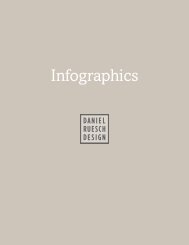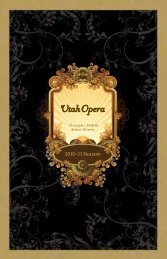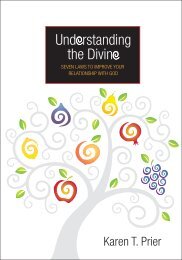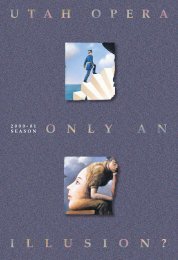Trusted Advisor_sample
The Trusted Advisor sample layout. Designed by Daniel Ruesch. Written by Rick Ray
The Trusted Advisor sample layout. Designed by Daniel Ruesch. Written by Rick Ray
You also want an ePaper? Increase the reach of your titles
YUMPU automatically turns print PDFs into web optimized ePapers that Google loves.
THE<br />
TRUSTED<br />
ADVISOR<br />
Learn the Hidden<br />
Rules and Win<br />
the Game of<br />
Building Wealth<br />
RICK RAY
INTRODUCTION<br />
ARE YOU TRUSTING THE RIGHT<br />
PEOPLE WITH YOUR MONEY?<br />
“You have to learn the rules of the game. And then you have to<br />
play better than anyone else.”<br />
–ALBERT EINSTEIN<br />
IT WAS DECEMBER 2008 as the Russian icebreaker<br />
Akademic Ioffe left port on a pleasure cruise to<br />
Antarctica. On board was a group of former college<br />
roommates who decided a cruise would be a perfect<br />
place for a mini class reunion. When his roommate<br />
pitched him on the idea, Matt Weinstein’s first thought<br />
was, “Antarctica is the last place on earth I’d want to<br />
vacation to.” But as his fellow alumni explained the<br />
unique features of the cruise, he eventually decided to<br />
join in.<br />
After months of anticipation, the day of departure<br />
was upon him and, like all the other passengers, Matt<br />
was excited as the ship made way to the eerie frozen<br />
INTRODUCTION 9
continent. He was, by all measures, a very successful<br />
person who truly deserved this break from his hectic<br />
but highly fulfilling life. He was living the classic<br />
American dream. He had followed his passion by<br />
building a company doing, of all things, playing.<br />
Matt loved to play. In 1976 he was hired by the city<br />
of Philadelphia’s bicentennial committee to bring a<br />
unique form of interactive entertainment to the citywide<br />
festival celebrating its 200th birthday. Not only<br />
did he love being playful, but he also had the ability<br />
to create unique forms of play which had never been<br />
done before, things like tug-of-war contests using a<br />
retrofitted rope with three separate leads at each end<br />
so literally hundreds of people could play. He created<br />
and led people through dancing games for all age<br />
groups to participate in. People absolutely loved it.<br />
Matt realized he had a creative knack for innovating<br />
new games, which were the perfect blend of silly<br />
and fun. More importantly, his games accentuated<br />
cooperation over competition, so people had a<br />
bonding experience by playing together. Matt’s games<br />
built community.<br />
The entrepreneur in him saw a business opportunity,<br />
and he started a company called Playfair. By 2008<br />
the company was being hired by 350 colleges and<br />
universities to help freshman students adjust to their<br />
new surroundings and bond through play and dance.<br />
Playfair not only helped kids acclimate and make new<br />
friends, but it also became a hit at corporate events.<br />
10 THE TRUSTED ADVISOR
Matt not only played for a living, he also became a<br />
top 1 percent earner in the United States. He shared<br />
a beautiful home with his wife in the San Francisco<br />
Bay area, and meticulously saved until he had a<br />
substantial retirement account. He was living the good<br />
life. At age fifty-nine, though he was figuratively at the<br />
bottom of the world, he literally felt on top of the world.<br />
The trip had been going spectacularly when Matt was<br />
summoned to the bridge for a satellite telephone call.<br />
He was unalarmed because his speaker’s bureau<br />
informed him prior to departure they might need to<br />
call to confirm a potential speaking engagement. So<br />
as he eagerly approached the bridge he thought,<br />
“How cool is this? I’m with my old buddies confirming<br />
a high-paying gig via satellite phone on my way to<br />
Antarctica!”<br />
But instead of the speaker’s bureau on the other end,<br />
it was his wife, Geneen. “Matt, I just found out Bernie<br />
Madoff has been arrested, and we’ve lost every penny<br />
of our retirement fund.” He felt sick, like he had just<br />
been punched in the stomach. 1<br />
Bernie Madoff, of course, has become a household<br />
name after a federal investigation revealed his<br />
investment firm to be running a Ponzi scheme<br />
considered to be the largest financial fraud in U.S.<br />
history, estimated to have lost $18 billion of investors’<br />
money. 2 In 2009 he was sentenced to 150 years in<br />
prison, the maximum allowable by law. Unfortunately,<br />
INTRODUCTION 11
TRUSTED ADVISOR PRINCIPLE #1<br />
THE TRUSTED ADVISOR IS<br />
MISSION-DRIVEN, NOT MONEY-DRIVEN<br />
“You will get all you want in life if you help enough other<br />
people get what they want.”<br />
–ZIG ZIGLAR<br />
WHEN I FIRST STARTED WORKING in financial<br />
services as a Series 7 licensed investment<br />
broker, I was taught to look for the sale when I<br />
first met with prospects. I went into every client<br />
conversation thinking, “Where’s the sale? How<br />
can I generate a commission/fee and make<br />
money?” After a few years of doing this with mixed<br />
results, I visited with my coach and told him I was<br />
struggling. He told me my struggle came from<br />
being in conflict with my values. In short, although<br />
I had been taught to live selflessly and I believed<br />
in principle, I was acting selfishly. I wasn’t making<br />
a living because my prospects could smell my<br />
PRINCIPLE #1 19
“commission breath” and it created an invisible<br />
barrier in my relationships.<br />
My coach taught me the principle of value<br />
exchange— value follows value. In other words, we<br />
receive value after we create value for others. This<br />
is also known as the Law of Reciprocity: If we create<br />
enough value for other people, we will be taken<br />
care of. Thanks to that kind and wise advice from<br />
my coach, and by proving the Law of Reciprocity<br />
thousands of times, I’ve learned to shift my mindset<br />
from “Where’s the sale?” to “How can I add value to<br />
these people’s lives?”<br />
The intention of common advisors is to make a sale.<br />
The <strong>Trusted</strong> <strong>Advisor</strong> has the wisdom, experience,<br />
and caring which fuels a different intention: to put<br />
the client’s needs above his own.<br />
But let’s be honest here: Like everyone else, financial<br />
advisors have to earn a living. And if we don’t sell<br />
products or charge fees to clients, we don’t get paid.<br />
There’s nothing intrinsically wrong with commissions<br />
or fees—they make the exchange between client and<br />
advisor mutually profitable and sustainable. It’s just a<br />
matter of where the primary focus is for the advisor.<br />
Truth be told, one of the primary reasons common<br />
advisors focus on “making sales” is a lot of them are<br />
not in good financial shape personally—regardless<br />
of their production. I’ve known advisors who were<br />
making $1 million per year but who were spending<br />
more than they were earning. <strong>Advisor</strong>s who aren’t<br />
20 THE TRUSTED ADVISOR
making money, or who aren’t good at managing their<br />
own money, can be tempted to sell products that help<br />
themselves more than clients.<br />
Now, understand that I’m not bashing other advisors.<br />
As I said, I used to be that guy who was desperate to<br />
make the sale. I learned the hard way. Focusing on<br />
the sale, rather than on creating value for clients is<br />
fruitless. My point is to simply raise your awareness<br />
when you’re choosing a financial advisor to help you<br />
avoid the kind of advisors that I once was.<br />
Let’s examine some of the mistakes made by moneycentric<br />
advisors.<br />
Hammers and Nails<br />
You’ve heard the saying, “When all you have is a<br />
hammer, everything looks like a nail.” It’s highlyapplicable<br />
to common advisors. Many such advisors<br />
have access to, or are only incentivized to promote,<br />
a few basic products. In this scenario, their job is<br />
not to listen to you, analyze your goals and needs,<br />
understand where you want to go and then make<br />
recommendations that will help you get there. Their job<br />
is to simply push the products they have access to—no<br />
matter the clients’ age, financial situation, or goals.<br />
Let me give you an example of the hammer and<br />
nail analogy which I see all of the time. There is an<br />
insurance company I’m aware of who is obsessively<br />
fixated on the all-too-common “buy term and invest<br />
the difference” (BTID) strategy. Their advisors are<br />
PRINCIPLE #1 21
adamantly opposed to any type of permanent<br />
(cash value) life insurance. Their strategy may<br />
be appropriate for some people, but they don’t<br />
understand the benefits and usefulness of permanent<br />
life insurance for others. I’m not going to get into the<br />
technical details of these competing strategies here;<br />
my point is simply the fixation on BTID is another<br />
example of advisors carrying around hammers and<br />
seeing every problem as nails. For many people<br />
and many situations, the strategy is wrong and<br />
irresponsible and it simply won’t work in the real<br />
world. Unfortunately, the advisors who represent<br />
these companies are unaware of the damage they are<br />
inflicting on their clients until it’s too late.<br />
<strong>Trusted</strong> <strong>Advisor</strong>s, in contrast, have a full set of tools, and<br />
they use the appropriate one to solve each individual<br />
problem. They understand a twenty-four-year-old single<br />
man needs entirely different strategies than the sixtyfour-year-old<br />
retiring couple. They understand BTID<br />
may be useful in one specific situation, but permanent<br />
insurance may be far better in another.<br />
I’ve learned from experience my most important<br />
responsibility as a financial advisor is to listen. Before<br />
I even consider any products or strategies, I need to<br />
understand who my client is. I need to know what their<br />
assets are. I need to know where they’re exposed to<br />
potential dangers. I need to know their hopes and<br />
dreams. I need to know what’s important to them. I<br />
need to know exactly what they want to accomplish.<br />
22 THE TRUSTED ADVISOR
How to Differentiate Between Money-Driven<br />
<strong>Advisor</strong>s and Mission-Driven <strong>Advisor</strong>s<br />
Money-Driven<br />
<strong>Advisor</strong>s<br />
Start presentations by<br />
pitching products.<br />
Recommend<br />
products before fully<br />
understanding your<br />
situation.<br />
Recommend the same<br />
products and strategies<br />
to almost every<br />
prospect.<br />
Use hype and<br />
manipulation to sell.<br />
Sell based on<br />
speculative<br />
hypotheticals and<br />
opinions.<br />
Represent and<br />
advocate for product<br />
manufacturers.<br />
Mission-Driven<br />
<strong>Advisor</strong>s<br />
Start presentations by<br />
asking questions.<br />
Never make<br />
recommendations until<br />
they understand your<br />
specific situation in<br />
depth.<br />
Recommend different<br />
products and<br />
strategies to different<br />
prospects.<br />
Use wisdom and<br />
caring to help.<br />
Recommend based on<br />
math and science.<br />
Represent and<br />
advocate for clients.<br />
PRINCIPLE #1 31
















